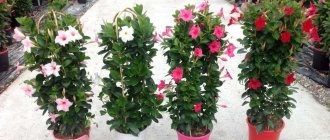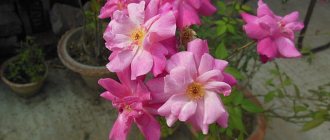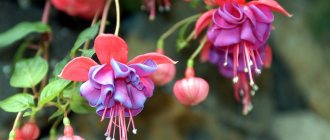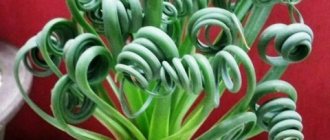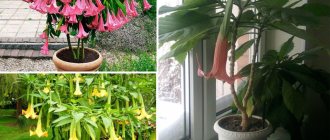Campsis is a wonderful liana with beautiful and large flowers that grows in the south of the Russian Federation. Most often it can be seen in the Krasnodar Territory and Crimea. The name is taken from the Greek language, where “kamptein” means “bending, twisting.” This plant prefers warmth, but the varieties bred by breeders have made it possible to grow it in the middle regions of Russia and even in Siberia.
Campsis is often called Tecoma or Tecomaria, but it is a similar plant belonging to a different genus. These vines belong to the Bignoniaceae family. Both genera Campsis and Tekoma have been known in Europe since the 17th century, where they are used for vertical gardening of fences, walls, pillars, and are used in landscape design on figured supports.
Liana Kampsis: description
This is a deciduous woody vine, its length can reach up to 12 meters. Branching Campsis are also found. Fastening to the supports is carried out using small air roots. The Campsis flower is a honey plant that attracts insects: bees, wasps, flies, ants. Flowering duration is 3 months, from June to September. This perennial plant consists of:
- The leaves are odd-pinnate, compound, reaching a length of up to 30 cm, consisting of 7-11 medium-sized leaves, up to 6 cm. They are dark green, smooth on top and light, slightly hairy below.
- The flowers are odorless. Tubular, similar to “gramophones”, collected in short panicles, concentrated at the tips of the shoots, up to 10 in length, with a diameter of 5 cm. The color depends on the variety of vine and can be orange-red (natural color), pink, crimson, red-golden. Reddish veins run along the inner surface from the center. The bracts look like green leaflets, and in some cases almost the same color as the “gramophone”.
- The fruits have the shape of a leathery, elongated up to 10 cm, pod, which consists of two halves. Inside it are flying winged seeds. When it bursts, they spread throughout the entire area.
A description of Campsis would be incomplete without pointing out that the stem of the vine is initially green-brown, but as it grows it becomes woodier and becomes much darker.
Mr. Summer Resident explains why Kampsis does not bloom
Many gardeners face this problem. If bignonia was bred from seeds, the plant will bloom for the first time only after 5-6 years, so it is much more productive to propagate it vegetatively.
When cuttings are taken, the vine produces buds within 3-4 years. However, you can speed up the development process by regularly fertilizing and maintaining the nutritional value of the substrate.
Another reason for the lack of flowering may be various diseases or infections that occur due to improper care or infection from other plants. Insect pests that deplete the vitality of bignonia also negatively affect not only its flowering, but also threaten the full growth of the vine.
In addition, improper care, namely too low a temperature, makes flowering impossible. It is important to protect Kampsis from spring and autumn frosts by covering it with special flooring. Frequent drafts stop the ripening of buds; in the future, if they are not prevented, the plant may get sick. You should not expect bignonia to bloom in regions with cold climates, where the air does not warm up by more than +20 °C.
Types and varieties of Campsis
This flowering vine has been cultivated in Europe for about 300 years. It should be noted that the genus Campsis has two species, differing in shape from each other. From them, using selective selection, hybrids were bred that retained all the main characteristics and were bred exclusively for flowers. Let's look at each genus separately.
Campsis rooting
Its homeland is the North American continent, where it can be found in the wild. A large plant, reaching a length of up to 12 meters. It has aerial roots, with the support of which it is fixed on supports. The odd-pinnate leaves reach 20 cm in length, they are darkish above and light below. Rarely pubescent over the entire surface of the lower part, or thin hairs are located partially along the veins of the leaves.
The flowers have a tubular-funnel-shaped configuration with a length of up to 10, a diameter of up to 5 cm. The corolla is orange in color and ends with bright red flaps. Flowers in the amount of 10-15 pieces are concentrated in the upper part of the shoot. Flowering occurs gradually. This allows the vine to remain elegant until autumn. Based on this genus, the following varieties were bred:
- Fabulous . In appearance it looks like a shrub with thin and rather long branches with orange-red flowers;
- Flamenco . Campsis has bright orange-purple flowers and can bloom until frost;
- Early . It got its name because flowering occurs almost a month earlier than other varieties. It has all shades of red: scarlet, porphyry, red;
- Golden . Blooms with beautiful yellow bright flowers;
- Dark purple . It has all the characteristics of the original species, but the flowers are large and their color is purple;
- Judy . Campsis is a vigorous vine. Its length reaches 15 meters or more. The characteristic features correspond to the rooting genus. It has an original coloring of flowers - an orange neck and bright yellow lapels.
Campsis rooting Flamenco
Campsis rooting Judy
Campsis rooting Magnificent
Large-flowered (Chinese)
The basic species is found naturally in Japan and China. The main difference from the rooting Campsis:
- absence of air roots;
- less resistant to cold;
- flowers larger than those of its fellow, yellow-orange shades;
- The vine is not long, so it mostly looks like a bush.
For other characteristic features it is identical to the rooting genus. Its peculiarity is the massive blooming of all flowers. The bush is almost completely covered with flowers. The duration of intensive flowering is a month-long period, after which rare flowers appear on the vine.
Hybrid
For the most part these are shrubs, but there are hybrid Campsis vines with large flowers of different shades. Adapted to cold climates.
Campsis hybrid
general information
In nature, Kampsis or Tecoma grows mainly in North America, and can stretch its shoots up to 15 m. In fact, it is a decorative flowering vine, but some varieties can be formed as standard trees.
Campsis is a large and tall plant with a powerful root system. Flexible shoots become woody with age and become covered with aerial roots. The leaves have a curious serrated edge, and the flowers are red or orange. Campsis blooms in June and continues to bloom until frost.
Photo: zen.yandex.ru
Reproduction of Campsis
This vine multiplies without problems if planting and care rules are followed. There are several ways to plant plants in parks and gardens.
Seeds
This method is labor-intensive and is used when there is no material for propagation by other methods. It has a number of disadvantages:
- flowering should be expected after seven years;
- When planting seeds, the characteristics of the variety are practically not inherited.
It is necessary to plant the seeds in the spring in boxes with pallets, which are filled with soil that has a neutral reaction. They are planted to a depth of 5 mm, after which they are watered. Place in a room with a temperature of 25 degrees. After about a month you can see the first shoots. After the formation of three leaves, planting is carried out in a permanent place.
By cuttings
Harvesting Campsis cuttings takes place in June-July. The sticks should be 10-15 cm and always green. A few leaves, shortened by 1/3, are left in the upper part. They are planted in a pre-prepared place, preferably in the shade, at an angle of 45 degrees, watered and mulched with compost, peat chips or humus. The guaranteed germination percentage is very high and amounts to 90%.
When using one-year-old woody cuttings, planting is carried out in early spring, without preparation, directly into the ground with a slope of 45 degrees. In this case, the entire cutting takes root.
Root shoots
In autumn, when the plant sheds its leaves, or in early spring, Campsis is propagated by dividing the roots. In this case, part of the root is dug up and immediately planted in the prepared place. It is watered and mulched. This method is very effective, since almost all shoots take root.
By layering
Reproduction can also be done using layering. This action is performed in early spring. The shoot closest to the ground is tilted into the dug hole, trying to get the aerial roots there, secured with a small but long pin made of aluminum wire, and covered with earth. During the summer, the soil in this place is carefully loosened and the place where the cuttings land is watered. The next spring, it is cut off from the mother plant, dug up and planted in a permanent place.
Planting seeds using seedling method
The seed method is rarely used, because after such planting, flowering occurs no earlier than after 5-7 years.
Time to board
Planting of seeds in the ground is carried out in early spring, in early March.
Selection of capacity
A shallow wooden box is selected, into which fertile soil is poured.
Preparing soil and seed
The soil for seeds should be loose, with a neutral acidity level. The soil is well moistened. Seeds do not require preliminary preparation for planting. The seed is buried no more than 5 mm and covered with a thin layer of soil on top.
The box with seeds is exposed to the sun and kept in a warm room at night. The soil is moistened as the soil dries out.
Seedling care
Seedlings appear in about 20-30 days. Watering - as needed. The soil should be kept slightly moist, but not overwatered, otherwise the young roots will begin to rot. When 5-6 leaves appear on the shoots, they can be transplanted to a permanent place.
Additional Information! It is recommended to plant a vine by seed only if it is not possible to use other methods of flower propagation. Seeds do not convey all the characteristics of the mother flower, and it also takes too long to wait for a new plant to bloom.
Kampsis seeds are extremely rarely used for planting
Dive
Young shoots ready for transplantation are carefully removed from the soil. It is important to preserve a lump of earth around the roots so that the plant can more easily tolerate replanting. A hole is prepared to a depth that will completely accommodate the root system. The soil must first be nourished with complex fertilizers. The seedlings are placed in the hole, sprinkled with soil, lightly compacted and watered.
Conditions for Campsis
In order for the liana to feel comfortable, it is necessary to create certain conditions for its life and development. These are, first of all, soil, sun, ambient temperature, care. Campsis is an unpretentious plant, but when good conditions are created, it responds gratefully with massive flowering and growth.
Place on site
We should not forget that despite adaptation to cold temperatures, this is a southern plant. Therefore, the area where the vine will grow must be sunny and protected from drafts. It is necessary to take into account the purpose for which the plant is planted and be sure to provide the vine with a place for weaving. This could be a fence, wall, pillars, special devices. Otherwise, it will creep along the ground, crawl through trees and bushes.
The soil
The plant grows absolutely calmly on any soil, even on poor calcareous ones. But the result is important - the vine will not bloom on them. Here, after planting Campsis, it needs fertilizing, which is carried out with mineral fertilizers. Organic supplements will also help in this case. On good soils, the plant will grow actively and bloom without them.
Temperature
For central Russia, winter hardiness of Campsis is not high. The plant tolerates temperatures down to –20 degrees. without any shelter. Even if part of it is frozen, the plant will quickly recover. But under more severe conditions, it must be insulated. The vine tolerates heat well, but watering must be daily.
Pests and diseases
If the soil is waterlogged, the roots of the vine can rot. Since the plant’s root system quickly recovers, to solve the problem it is enough to reduce watering and remove the affected areas.
Campsis flowers do not smell, but the flower nectar attracts aphids, flies. Insecticides are used against them.
Kampsis will decorate gazebos, flower beds and gentle slopes. It makes interesting standard forms, geometric compositions and hedges. Campsis is grown in containers for landscaping winter gardens, glazed and insulated balconies and loggias.
You can learn other interesting points in growing campsis from the video.
Growing in open ground
The process involves compliance with established planting rules and further care: watering, loosening, weed control. Proper cultivation and care of Campsis will bring satisfaction to the gardener with the gorgeous appearance of the plant.
Landing rules
In order for the planted seedlings to grow and develop well, you need to pay maximum attention to the flower. It will answer you with thick, beautiful foliage and massive flowering. The key to this is neutral or slightly acidic soil. Planting and caring for Kampsis is carried out according to established rules. If the soil is poor in the autumn, a special hole with a diameter of 0.5 and a depth of 0.6 m is prepared. The principle of its construction is quite simple:
- Drainage. When performing this, a gravel mixture consisting of sand, gravel and expanded clay is poured onto the bottom.
- Humus - 5 kg is poured into the hole.
- Complex mineral fertilizer – 500 ml, which is carefully mixed with organic matter.
Cover with soil, which should rise like a mound and leave until spring. In April, after the frost has passed, seedlings are planted in a hole. If the soil is normal, it is planted directly into the ground at a 45 degree angle.
Watering
Under natural conditions, the vine can remain without water for a long time, but for good flowering it needs regular watering, especially in the absence of rain for a long time. This condition is mandatory. Despite the fact that this plant is drought-resistant, without regular moisture consumption it will not bloom profusely.
Feeding
On fertile lands, Kampsis does not need feeding. But on poor soils it will be needed. Nitrogen-phosphorus fertilizers are suitable here. It is their addition that will ensure strong flowering.
Trimming and shaping
The plant is prone to vigorous growth. Therefore, here we need to regulate its growth and its spreading in width. Peduncles form on new branches, so the old ones are removed. This will provoke a massive appearance of Campsis buds in the spring. In addition, pruning will give the vine the desired shape. The pruning technology is as follows:
- On a young vine, two or three developed shoots are selected. Others are removed with pruning shears;
- they are secured to the support in the correct direction;
- This procedure is carried out for several years until the trunk is formed to the desired size.
Later, woody branches and several young ones are left. Three buds are preserved on them, the rest are cut off. When pruning Campsis it is possible to create any shape.
Loosening, mulching, weeding
These gardening tasks are essential for all plants. When loosening, oxygen enters the soil. If you do not control weeds, which absorb nutrients from the soil, then the area will look sloppy. Mulching helps retain moisture in the soil.
Bloom
In order for the Campsis plant to bloom in the second or third year, it is necessary to plant it with cuttings. After the roots appear, plant it in a special hole prepared according to the principle described above. During the flowering period, faded branches are removed. This will stimulate the formation of new inflorescences.
Preparing for winter
This procedure is similar to preparing grapes for wintering. To carry it out you will have to remove the vine from the supports. Tie the lashes, lay them evenly on the roots, cover them with spruce branches on top or cover them with a thick layer of sawdust and fallen leaves. Cover everything with film, on top of which fir branches are laid or covered with earth.
When and how does it bloom:
Each vine variety has its own flowering period. The beginning of the appearance of flowers and the duration of flowering depend on climate and weather. Campsis in the Urals, which is not difficult to grow, blooms later due to the cold spring weather. In a zone with a temperate and warm climate, flowering begins in June and July.
Types of flowers
Depending on the variety, flowers can be small, with a diameter of no more than 5 cm, and large, up to 8 cm.
Additional Information! Campsis is a non-poisonous flower; it can be safely planted in the area near the house.
Flower shapes
The flower consists of several, mainly 5 petals, which are connected at the base, the edges are bent to the sides.
Flowering period
The tree vine blooms all season.
Changes in care during the flowering period
It is easy to care for the vine during its flowering period - just increase watering. As the flowers fade, they need to be removed.
Campsis in landscape design
Compositions featuring flowering vines can transform a garden plot beyond recognition. No wonder it has been used for decoration in landscape design for hundreds of years. In most cases, it is used as vertical gardening. When pruning, you can form a real flowering tree or bushes. The main tool for creating compositions is a pruner, decorative elements and imagination.
Share
Planting in the garden
Usually, when planted correctly, Kampsis blooms already in the second or third year of life. It is best to plant already rooted cuttings taken from an adult vine, which blooms profusely.
Also keep in mind when planting that Kampsis is a rather aggressive plant that quickly takes over the area around it. Therefore, metal or slate shields should be dug around the seedling to a depth of at least 80 cm.
To plant a plant, you should dig a planting hole according to the size of the root system of the seedling. The soil taken out of the pit is mixed with mature compost, and 500 grams of complex mineral fertilizer is added to the mixture. It is enough to take about 5 kg of compost. Part of the nutrient mixture is placed at the bottom of the hole, then the seedling is planted and covered with the remaining nutrient mixture. Immediately you need to make a support for the vine.
Landing site and optimal soil
To plant Kampsis, you should choose an open area with plenty of space for further growth and development. There are two important factors to consider.
Firstly, the place must be sunny; in the shade the plant will develop very slowly.
Secondly, if the gardener’s choice falls on a rooting campsis, then it will not be possible to plant it in close proximity to buildings; aerial roots can cause damage to the foundation or walls of buildings.
Campsis is not picky about the composition of the soil in which it will grow, but nutritious, loose soil that is not prone to stagnation of water is optimal for the plant.
The most common vines in Russia
Perennial flowering vines for the garden include honeysuckle, clematis, climbing rose, and campsis.
Clematis is the most common garden vine in Russia. Breeders have developed a huge number of clematis varieties, including large-flowered and small-flowered plants with flowers of various shades. This variety of vines is quite whimsical; clematis requires special care, but its beauty is undeniable.
The veranda twined with blue clematis looks very beautiful
It will help make even a nondescript house cozy and attractive. A pillar, porch, fence, braided with stems with bright flowers, will be full of colors, uplifting your mood.
Porch decorated with clematis. You can also let it trudge along special gratings, placing them against the walls of the house.
Honeysuckle honeysuckle has become quite popular in our gardens due to its unpretentiousness. This plant has two-colored inflorescences raised towards the sun with a wonderful aroma. If you use honeysuckle to decorate your gazebo, in addition to the beauty of the flowers, you can also enjoy their scent.
Honeysuckle bush transforms the look of an old fence
Campsis is a very beautiful flowering vine with red, bell-shaped flowers. Unfortunately, Kampsis is quite thermophilic and cannot always survive our harsh winters. For the winter, the roots of the plant need to be covered. But Kampsis grows well in the city; polluted air does not frighten it. There are also yellow, lilac, and pink capmsis, but red is the most commonly found variety.
This is a tree-like vine. The perennial plant has a trunk and a luxurious flowering crown. Kamsis looks equally good if its shoots wrap around a pergola or against a fence, as long as it has enough sun.
You can learn how to build a pergola yourself from the material:
Bright Kampsis flowers will decorate any garden
An adult plant perfectly decorates the entrance to the yard
Climbing roses are a decoration for any garden. For us, this is about the same as sakura for the Japanese. You can admire these flowers and contemplate them endlessly. They bloom for a long time, abundantly, and are not afraid of drought. A pergola, fence, bench and wall of the house - all this will be a good support for climbing roses. And they are easy to care for - buy and plant the bush you like, water it regularly and feed it with fertilizers 2-3 times a season.
Climbing roses need support
Arches made of climbing roses look gorgeous - very often newlyweds look for such places for weddings
Attention! Some garden vines do not tolerate metal supports well, and in winter the shoots can be seriously damaged, so they must be used with caution, and shoots must be removed from the supports in winter. It is difficult to refuse them, because... It is with the help of metal supports that you can create the most beautiful arches.
Ivy is a non-flowering climbing garden plant. It is completely unpretentious and grows well in the shade. Whatever place you give it in the garden, it will grow everywhere, you just need to make sure that the soil at the roots is always moist. Ivy loves moisture, forming luxurious thickets. Ivy shoots are securely attached to almost any surface, clinging to the slightest roughness. It is an evergreen plant that usually survives winter without problems.
Recent Entries
Lilac perennials that are beautiful, compact and do not crowd out other plants Why when buying seedlings you should not take the sellers’ word for it and how to determine the age of the plant using 3 signs Tomato seedlings have turned purple or whitish: why the color has changed and how to save the plants
Ivy is capable of entwining the entire house with its tenacious shoots, giving it a fabulous look.
Wild grapes are a well-known unpretentious vine that can grow anywhere. Wild grapes will make a garden gazebo a shady, secluded place, beautifully entwining a fence, balcony or wall of a house. Its leaves, which are beginning to turn red, are especially beautiful in autumn. This vine does not require any support or special care.
Climbing roses and wild grapes go well together
Advice. Non-flowering vines can be used as a background for flowering ones. For example, against the background of an ivy-covered wall, any plant with bright flowers will look advantageous.
